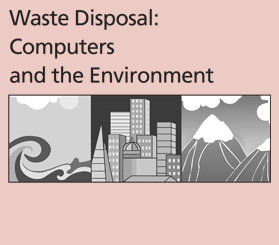Waste Disposal: Computers and the Environment – Module Issues in the News for Students

News
A Three-And-A-Half Pound Computer Chip?
It sounds ridiculous that a computer microchip could be 3.5 pounds! But that’s the weight of the estimated energy needed to produce one computer chip. Scientists say that a microchip that weighs 2 grams requires at least 3.7 pounds of fossil fuels and chemicals to produce.
Researchers looked at the life cycle of a microchip from the raw materials to the finished product. They considered such things as the amount of carbon dioxide released from fossil fuels during chip production. They also looked at the impact of the chemicals used during production on air, water and soil. They found that each chip required 3.5 pounds of fossil fuels, 0.16 pounds of chemicals, 70.5 pounds of water and 1.5 pounds of elemental gases (mainly nitrogen).
Many experts believe that, as technology increases, the amount of materials and energy needed to produce new products will decrease. This is known as dematerialization. The microchip is often used as a prime example of dematerialization because of its high efficiency and small size. This study, headed by Dr. Eric Williams of the United Nations University in Tokyo, Japan, seems to suggest otherwise.
Safety in Your Community
Do you know if there is a chemical plant in your community?
Has there been a chemical accident in your community within the last five years?
Do you know what to do if an accident occurs?
If you answered “no” to these questions, you are like the majority of people in the United States, according to a study done in 2003 by the State of Texas’ Engineering Experiment Station’s Process Safety Center.
The study found the top five most released chemicals in the United States in the last 10 years were: ammonia, chlorine, hydrogen, propane and formaldehyde. It said chemical spills with related injuries and fatalities are probably declining, but no one knows for sure because the information is not nationally tracked.
“We need to have a better informed public—where the public trusts the information coming out of the chemical industry—so people are better able to deal with emergencies such as chemical incidents,” said Dr. Sam Mannan, director of the study. “Public trust is essential for improved safety.”

